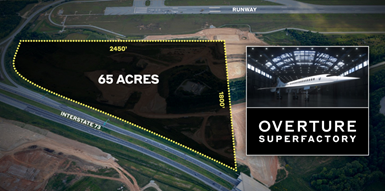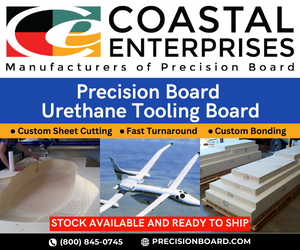Boom Supersonic selects Greensboro, N.C. for airliner manufacturing facility
400,000-square-foot Overture Superfactory in Piedmont Triad Area to break ground in 2022, begin production in 2024 and add local jobs and provide university internships by 2032.

Overture supersonic aircraft. Photo Credit, all images: Boom Supersonic
On Jan. 26 Boom Supersonic (Denver, Colo., U.S.) announced it has selected the Piedmont Triad International Airport in Greensboro, N.C., U.S. as the site of its first full-scale manufacturing facility, the Overture Superfactory.
The Overture Superfactory will be a state-of-the-art manufacturing facility, including the final assembly line, test facility and customer delivery center for the Overture supersonic airliner. Carrying 65-88 passengers, Boom Supersonic contends that Overture will be capable of flying on 100% sustainable aviation fuel (SAF) at twice the speed of today’s fastest passenger jets.
“Selecting the site for Overture manufacturing is a significant step forward in bringing sustainable supersonic air travel to passengers and airlines,” says Blake Scholl, founder and CEO of Boom Supersonic. “With some of the country’s best and brightest aviation talent, key suppliers and the state of North Carolina’s continued support, Boom is confident that Greensboro will emerge as the world’s supersonic manufacturing hub.”
North Carolina offers Boom an optimal location for its manufacturing facility thanks to its strong aerospace workforce, which includes a large number of U.S. military veterans. North Carolina also affords good access to technical schools, providing Boom with a pipeline of skilled labor. The Piedmont Triad area is in close proximity to many Tier 1 aerospace suppliers, benefitting Boom as Overture production ramps (see “U.S. Air Force contract accelerates R&D of Boom Supersonic’s Overture aircraft”). Additionally, the close proximity to the eastern seaboard facilitates supersonic flight testing over the Atlantic Ocean. Boom corporate headquarters remains just outside of Denver, Colo., U.S.
The Overture Superfactory will be approximately 400,000 square feet and constructed on a 65-acre campus at the Piedmont Triad International Airport. Moreover, Boom says it will bring more than 1,750 jobs to North Carolina by 2030, expanding to a total of more than 2,400 jobs by 2032. North Carolina economists estimate that the Overture Superfactory will grow the state’s economy by at least $32.3 billion over 20 years.
To develop the next generation of supersonic professionals, Boom will also create 200 internships through 2032 for students who attend publicly funded North Carolina universities, community colleges or technical schools.
“It is both poetic and logical that Boom Supersonic would choose the state that’s first in flight for its first manufacturing plant,” said North Carolina Governor Roy Cooper during the press conference announcement. “Like the success of the Wright Brothers at Kitty Hawk, this innovative company will succeed by transforming passenger air travel with speed and sustainable energy.”
Boom expects to break ground later this year on the Overture Superfactory and will begin production in 2024. The first Overture aircraft is slated to roll out in 2025, fly in 2026, and carry its first passengers by 2029. Commercial interest in Overture, including orders and options, totals $14 billion from United Airlines and Japan Airlines. Boom is also working with the U.S. Air Force on government applications of the aircraft.
Related Content
-
Plant tour: Joby Aviation, Marina, Calif., U.S.
As the advanced air mobility market begins to take shape, market leader Joby Aviation works to industrialize composites manufacturing for its first-generation, composites-intensive, all-electric air taxi.
-
The potential for thermoplastic composite nacelles
Collins Aerospace draws on global team, decades of experience to demonstrate large, curved AFP and welded structures for the next generation of aircraft.
-
Next-generation airship design enabled by modern composites
LTA Research’s proof-of-concept Pathfinder 1 modernizes a fully rigid airship design with a largely carbon fiber composite frame. R&D has already begun on higher volume, more automated manufacturing for the future.

















